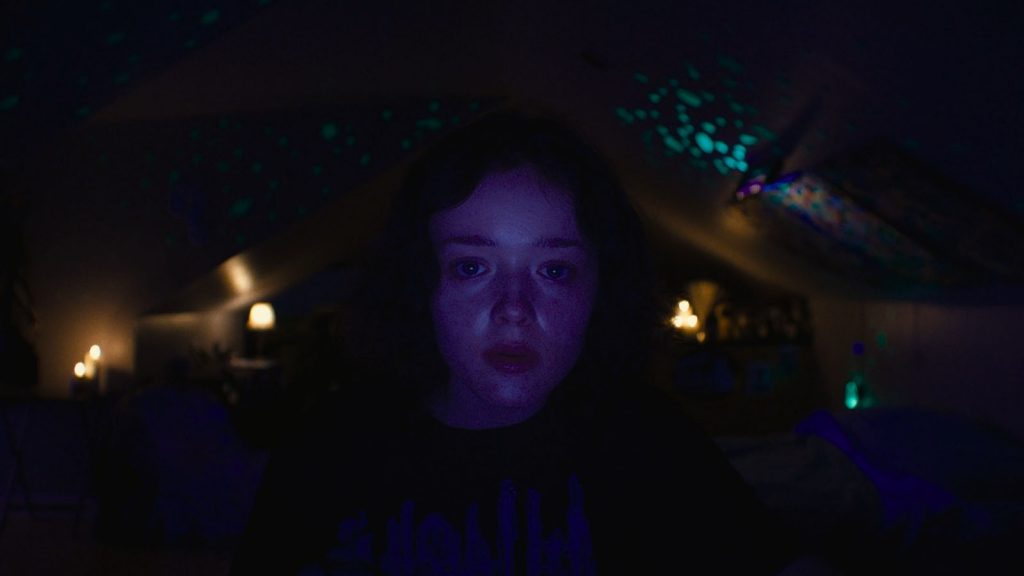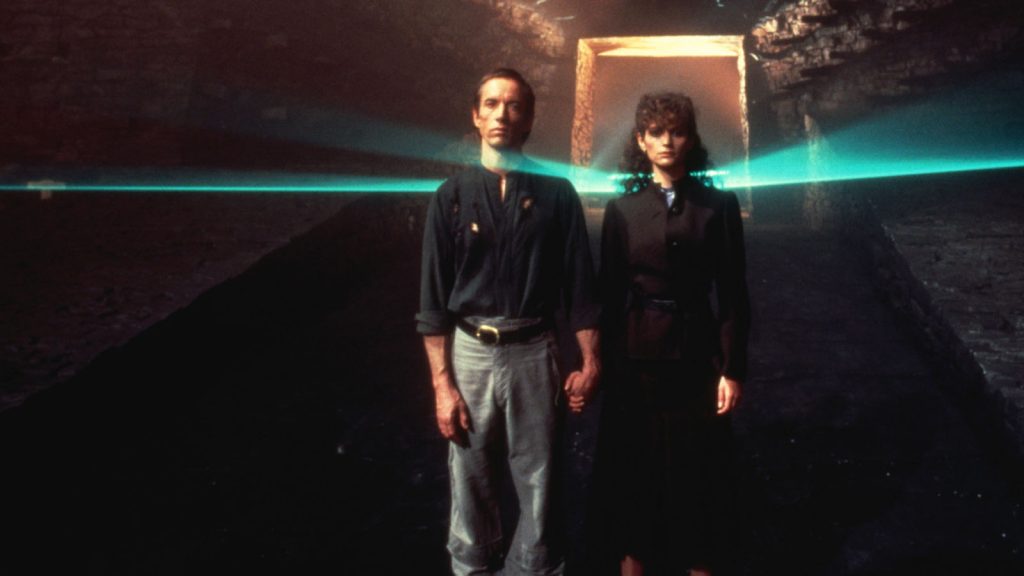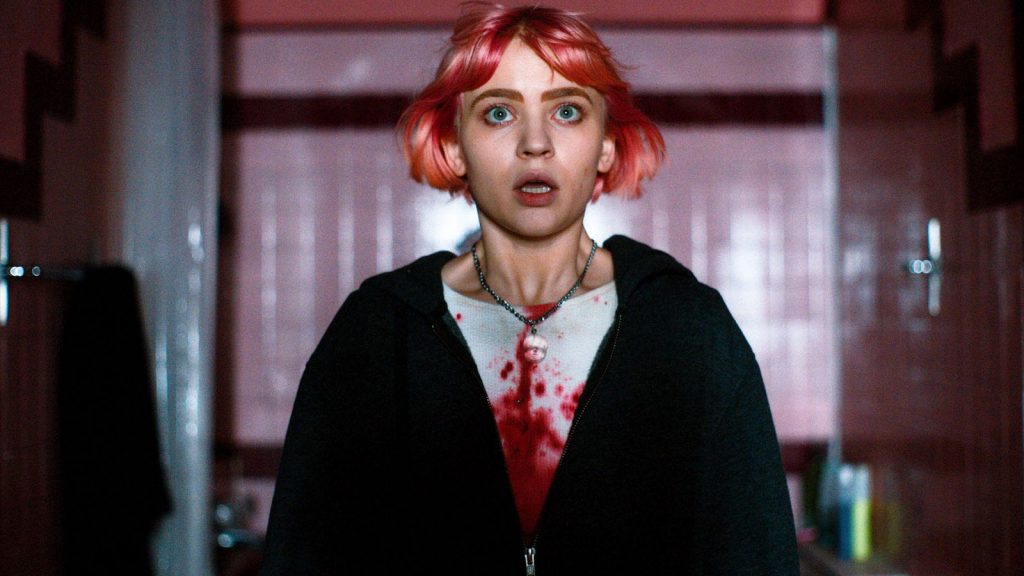
I haven’t seen Jane Schoenbrun’s first feature, a 2018 documentary entitled A Self-Induced Hallucination. The film’s IMDb page offers a teasingly terse synopsis: “It’s about the internet, and it’s quite strange.” Schoenbrun’s fictional follow-up, a chamber horror that is strange, about the internet, and is concerned with self-induced hallucinations, appears to be a sort of companion piece, suggesting that the writer-director is staking a claim in the eerily interactive liminal landscape that separates the ethereal from the corporeal—a terrain populated by somnambulists, insomniacs, and loners. We’re All Going to the World’s Fair is mostly a monodrama, presented via a combination of video posts, Instagram stories, Skype conversations, direct-to-webcam monologues, and omniscient audiovisual narration, this last element often assuming an alienating objectivist distance, as though seeking respite from the oppressively close, selfie-obsessed proximity of most web-based communication.
The film’s protagonist is Casey (Anna Cobb), an adolescent who is perpetually online and very attentive to mood lighting. She seems left to her own devices, entirely alone save a rare, unhappy voice heard bemoaning from somewhere outside her attic girl cave, and resides someplace characterized by abandoned strip malls and wintry woods. Casey is very into the “World’s Fair Challenge,” an internet game that demands its players document any physical or psychical metamorphoses deriving from exposure to the host site. Like Ringu, Funny Games, Videodrome, or the recently restored Arrebato (which I reviewed in this publication last year), We’re All Going to the World’s Fair operates on the understanding that certain kinds of images and sounds can alter us palpably, like radiation, an ancient curse, or an airborne virus—an idea that feels less far-out in 2022 than it did in the disparate eras of these predecessors. “I love horror movies,” explains Casey, “and I thought it might be cool to try actually living in one.” If We’re All Going to the World’s Fair owes anything to Michael Haneke in particular, it is this sense that the gamification of everything has had an evaporating effect on affect, fueling a longing for any kind of stimulating firsthand experience, even a traumatic one. Casey’s fixation on “World’s Fair Challenge” is surely exacerbated by her isolation. Her sole interlocutor is one JLB (Michael J Rogers), a middle-aged fellow web addict who speaks to Casey in a voice resembling John Malkovich with a respiratory issue, but who appears on her computer screen only as a very metal avatar: Casey never meets JLB IRL. JLB’s disembodied creepiness is enhanced by his request that Casey video herself sleeping as a way for him to know she’s safe. It is to the film’s benefit, however, that JLB emerges as less flatly sinister than his online presence would suggest.

What’s most interesting about We’re All Going to the World’s Fair as a horror film is that the threat is not a matter of something coming to get you, but rather what you will become. Akin to a vampire requiring an invitation, a victim’s complicity in “World’s Fair Challenge” seems essential to its formula. (This method of allowing an individual to opt in to their own peril shares a curious kinship with Dan Erickson’s Apple TV+ series Severance—indeed, We’re All Going to the World’s Fair even features a reference to finger traps.) At this point in human history, the idea that we are knowingly signing off on our own demise might be the film’s most resonant subtext, though the idea just sort of presents itself for our admiration. All of this is to say that the film is conceptually interesting and dramatically boring. This boredom—which manifests in, for example, aimless shots of prolonged duration, a static sequence in which Casey performs an uninspired song-and-dance routine for her webcam, or an ASMR video playing out in its entirety—is on one hand part of a classical genre strategy to spook the viewer through disorientation or cultivate “boo” moments. On the other hand, boredom is a way to mirror the experience of prolonged screen time—something that Casey, depicted as semi-hypnotized (and embodied by Cobb, with her remarkable Kewpie-doll stare), seems to have been shaped by. Perhaps ironically, given that it is the means through which millions watch movies daily, the internet remains resistant to being realized as dynamic cinema, which may go some way toward explaining why the characters in We’re All Going to the World’s Fair come across as phantoms or semi-synthetic beings, rather than flesh-and-blood people brimming with volition, passion, and contradiction. 🩸

is a freelance critic and playwright.
We go to the movies to see ghosts, whether they be the likenesses of long-gone actors, objects, or edifices, or the suggestion of specters imprinted in the gloom of otherwise benign images.
BY JOSÉ TEODORO | February 2, 2023
The word alone induces twinges of dread and disgust: “influencer,” along with its evil siblings “vlogger,” “social media personality,” “YouTuber,” and “TikTok sensation”...
BY LAURA KERN | May 25, 2023
The TV is always on in Fatal Pulse, the most recent release from underground horror legend Damon Packard. Set in 1991, Packard’s 2018 film is drenched in pinkish-bluish gel lighting...
BY CHLOE LIZOTTE | October 31, 2021

This pre-Code offering packs a lot of story into its typically brisk running time, with several plot threads weaving together a (not always successful) tapestry of spooky and criminal doings.
READ MORE >
BY ANN OLSSON | Month 00, 2021

In what could be the fastest-resulting rape revenge movie, a drunken lout brutally forces himself on Ida, the young woman who doesn't return his affections, during a party over Labor Day.
READ MORE >
BY LAURA KERN | Month 00, 2021

Beast is a lot of movies in one package - fractured fairy tale, belated-coming-of-age story, psychological drama, regional horror film - but above all it's a calling card for its leading lady, Jessie Buckley.
READ MORE >
BY LAURA KERN | Month 00, 2021